Injuries
Diagnosis
What is orofacial pain?
Orofacial pain is a collective term used for a number of complex orofacial pain and dysfunction disorders, which include dentoalveolar “dental” pain, neuropathic pain, nonodontogenic tooth pain, musculoskeletal pain, neurovascular pain, referred pain, headache, oromotor dysfunction, and mandibular behavioral disorders, all of which may results in symptoms of orofacial pain. The most common orofacial pain disorder involves dentaoalveolar or “dental” pain.
When people experience orofacial pain, their first call is often to their dentist or physician. Many different conditions will present with similar symptoms or symptoms that radiate to other areas often making it difficult to arrive at an accurate diagnosis. Without a correct diagnosis, it is virtually impossible to provide the care necessary to alleviate a person’s pain or source of infection. The vast majority of all orofacial pain is dentoalveolar “dental” pain which is caused by an organic problem such as dental caries (decay), dental abscess, cracked teeth, pulpitis, periodontitis (gum disease) or trauma, which when identified have many effective treatments to alleviate the pain and source of infection if present. Patients may also present with pain that appears to be from a dental problem but has a non-dental origin such as musculoskeletal pain or neurogenic pain, both of which may present with similar symptoms as dental pain. Since dental pain accounts for the majority of all orofacial pain experienced by patients it is important to first identify if pain is from a dental cause. Dr. Radatti is an experienced and thorough endodontist that works very hard to obtain the correct cause and diagnosis for head and neck pain. This in turn helps provide patients with a path to treatment options.
How we can help
Dr. Radatti specializes in the identification and diagnosis of dentoalveolar “dental” pain and infection. When patients present with orofacial pain, identifying the cause of pain is the initial step in providing care or referring patients for the appropriate care they need. In our practice we take great pride in our ability to help patients determine if their pain is truly caused by a dental problem and providing an accurate diagnosis so that effective dental treatment may be provided. If pain is determined to be of non-dental origins, this information is extremely vital for patients in pursuing appropriate care.
With the advancements in technology such as the surgical operating microscopes and 3 Dimensional Cone Beam Imaging (CBCT) we have the ability to successfully treat and preserve the health, function and esthetics of many teeth with root canal therapy and other advanced treatment options. As an endodontic specialist for over 20 years this path has had an extremely high success rate in allowing patients the ability to retain their own natural dentition. If you have been told that a tooth or multiple teeth need to be extracted, our practice may be able to offer an alternative that may be more conservative and cost effective than an extraction and dental implant. Our practice will provide you with a thorough examination to determine if preserving your natural tooth will provide the best long-term outcome or if extracting and replacing your tooth with an implant, bridge or denture is a preferred option.
Cracked Teeth
Cracked teeth demonstrate many types of symptoms, including pain when chewing, temperature sensitivities, or even the release of biting pressure. It is also common for tooth pain to come and go, making it difficult to diagnose the cause of discomfort.
Chewing can cause movement of the cracked pieces of your tooth, and the pulp within the tooth becomes irritated. At the same time, when biting pressure is released, the crack can close quickly, resulting in sharp pain. Eventually, the pulp will become damaged and tooth will consistently hurt, even when you are not chewing. It is possible that cracks can lead to infection of the pulp tissue, which can spread to the bone and gum surrounding the problematic tooth.
Types of Cracked Teeth
Craze Lines
These are tiny cracks that only affect the outer enamel of the tooth. These cracks are more common in adults. These types of cracks are superficial and are usually of no concern.
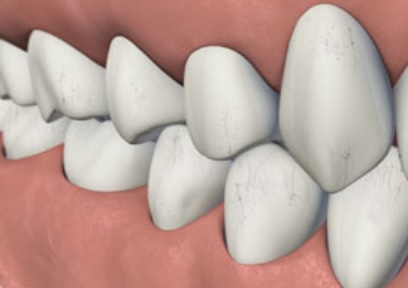
Fractured Cusp
When a cusp becomes weakened, a fracture may result. The cusp may break off or be removed by a dentist. A fractured cusp rarely damages the pulp, so root canal is not necessary. Your dentist will usually restore the tooth with a full crown.
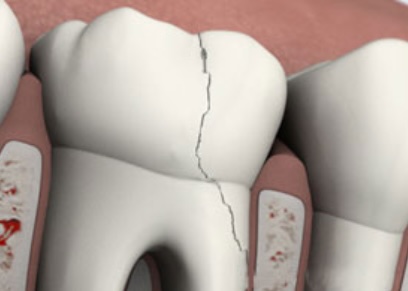
Treatable Cracked Tooth
This type of crack extends from the chewing surface of the tooth and vertically migrates towards the root. In some cases, the crack may extend below the gum line. It is possible for the crack to extend further into the root. Damage to the pulp is commonplace. In this case, root canal treatment is usually necessary.
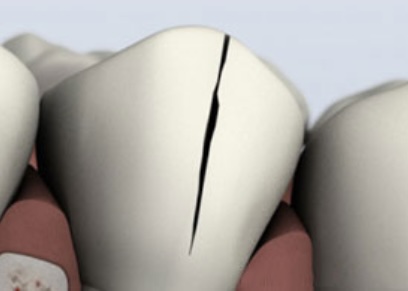
Vertical Root Fracture
A vertical root fracture is a crack that extends onto the root and usually warrants removal of the tooth. Sometimes the tooth can be saved for a number of years before removal is needed. There are a lot of factors that affect the prognosis of a tooth with cracks that extend to near or onto the root. Dr. Radatti will be very thorough and discuss all options with you if you have such fractures.
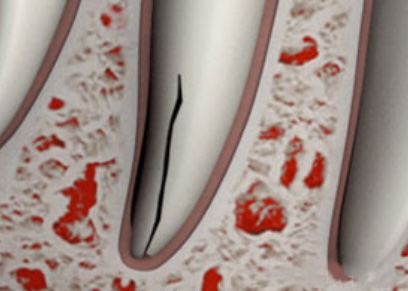
Split Tooth
A split tooth is usually the result of an untreated cracked tooth. It can be identified by a crack with distinct segments. This type of tooth can never be saved intact. Yet, the position and extent of the problem will dictate whether any portion of the tooth can be saved. Sometimes, endodontic retreatment by the doctors and restoration by your dentist can be used to save a portion of the tooth.
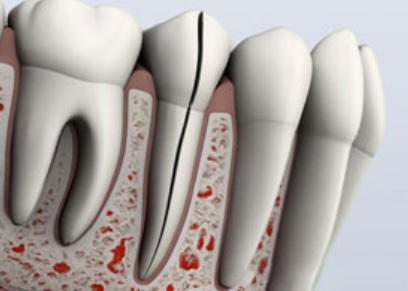
Traumatic Injuries
Dislodged Teeth
Injuries to the mouth can cause teeth to be pushed within or partially out of their sockets. Dr. Radatti or your general dentist may reposition and stabilize your teeth when this type of trauma occurs. It is important to have an evaluation of traumatized teeth to determine if the pulp is damaged to the point where root canal treatment is indicated. Root canal treatment, when indicated, is usually started within a few weeks of the injury and a medication, such as calcium hydroxide, will be placed inside the tooth. Eventually, a permanent root canal filling will be placed.
If the pulp of a traumatized tooth remains healthy, then no other treatment is necessary. Yet, if the pulp becomes damaged or infected, root canal treatment will be required. If left untreated, many different complications can arise. These complications can include but are not limited to: Infection of the tooth & surrounding tissue and potential loss of the tooth.
Avulsed Teeth
If an injury causes a tooth to be completely knocked out of your mouth, it is important that you are treated immediately! If this happens to you, keep the tooth moist (milk is a good option). If possible, put it back into the socket. A tooth can be saved if it remains moist. You can even put the tooth in milk or a glass of water (add a pinch of salt.) Dr. Radatti may start root canal treatment based upon the stage of root development. The length of time the tooth was out of your mouth and the way the tooth was stored, may influence the type of treatment you receive.
Tooth Injuries in Children
An injured immature tooth may need one of the following procedures to improve the chances of saving the tooth:
- Apexogenesis: This procedure encourages the root to continue development as the pulp is healed. Soft tissue is covered with medication to encourage growth. The tip of the root (apex) will continue to close as the child gets older. In turn, the walls of the root canal will thicken. If the pulp heals, no additional treatment will be necessary. The more mature the root becomes, the better the chance to save the tooth.
- Apexification: In this case, the unhealthy pulp is removed. The doctors place medication into the root to help a hard tissue form near the root tip. This hardened tissue provides a barrier for the root canal filling. At this point, the root canal walls will not continue to develop, making the tooth susceptible to fractures. So it is important to have the tooth properly restored by your dentist.
Root Resorption
What is Root Resorption?
Root resorption is the process in which the body breaks down and absorbs the root structure of a tooth. Although this is not common in adults, root resorption in children is natural and enables the roots of baby teeth to dissolve so that permanent teeth can serve as replacements.
Why Does Resorption Happen in Adults?
We often do not know the cause of root resorption in permanent teeth, but there are several factors which could act as contributors. Pressure and tension are normal stressors that can lead to breakdown in tissue, so years after excessive orthodontic force, a tooth may experience resorption. Likewise, trauma to a tooth may damage ligaments connecting the root to the jaw bone, resulting in the beginnings of resorption. Extreme teeth grinding and tooth-bleaching have been found to initiate resorption as well. The good news? Most patients with these risk factors never go on to develop any indicators of root resorption.
What Does Root Resorption Look Like?
It is most common for root resorption to begin from the outside of a tooth near the gum line and work its way inward in a process called external invasive cervical resorption (EICR). Pink spots are a common indicator that EICR is taking place. The eventual effects appear as holes, or cavity-like areas, at the gum line of the tooth.
Not nearly as common as EICR, internal resorption begins from the inside of the root and is often due to chronic pulp inflammation. Because resorption is usually asymptomatic, most patients are unaware of their condition until well into the resorption process.
How is Root Resorption Treated?
If the initial pink spots on the tooth’s enamel are spotted and treated and repaired in time, no further dental care may be necessary. If, however, the defect extends near the pulp root canal therapy in addition to the repair of the external damage may be needed. Extraction and dental implant procedures are required for cases that the structural damage is too extensive to repair.
Since resorption is usually asymptomatic, detecting its presence in the initial stages isn’t always easy. Nonetheless, early treatment is crucial when it comes to saving the tooth, and as endodontists, our primary concern is to save your natural teeth. Call us at the first sign of root decay or resorption, so we can safely and gently provide you with the best possible care for maintaining your oral health well into the future.
Is Root Resorption Painful?
Surprisingly, no. Root resorption is generally asymptomatic. If you are experiencing pain, another factor may be the cause, and we encourage you to call us today to schedule a consultation. Bend Office Phone Number 541-617-9736